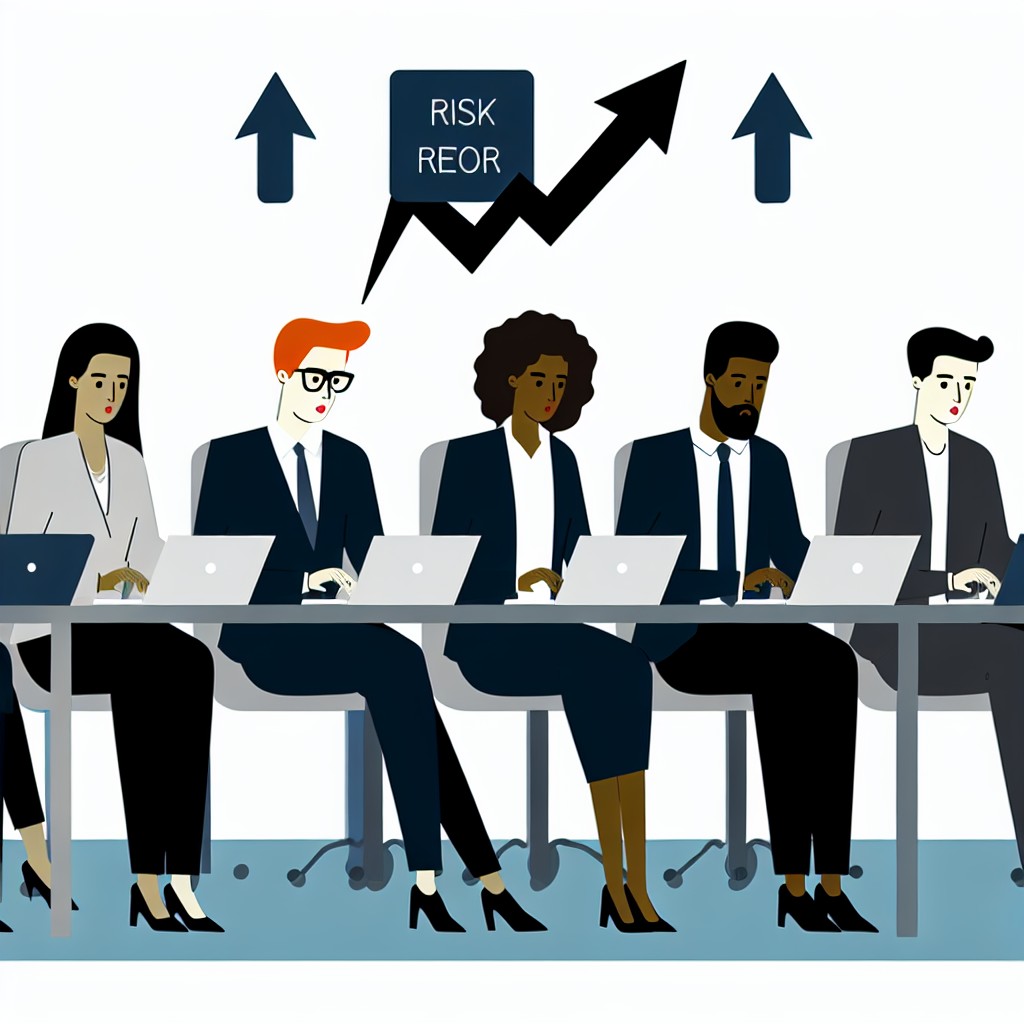Introduction
IT risks are potential threats to an organization’s information technology systems.
These risks could cause harm to the organization.
Addressing IT risks is important because they can lead to data breaches.
They can also cause financial losses and damage to reputation.
IT risk managers play a crucial role in identifying these risks.
They are responsible for mitigating potential threats to the IT infrastructure.
Risk managers assess threats and implement strategies to prevent or minimize harm.
Identify Common IT Risks
- One common IT risk is data breaches.
- Cyber attacks are another prevalent risk.
- System failures are also a significant risk.
- Human errors can also pose a threat to IT systems.
Each of these risks has the potential to have a significant impact on organizations.
- Data breaches can result in financial losses.
- They can cause damage to reputation and legal implications for non-compliance.
- Cyber attacks can lead to data theft.
- They can also disrupt services and cause loss of customer trust.
- System failures can cause downtime.
- They may lead to loss of productivity and damage to customer relationships.
- Human errors can result in data loss.
- They often cause decreased efficiency and compromised security measures.
Understanding these risks is crucial for IT risk managers.
They must address and mitigate these risks effectively.
Understand the Role of IT Risk Managers
Assessing IT risks is a crucial responsibility of IT risk managers.
Monitoring and managing IT risks help protect the organization.
Proactive risk management plays a significant role in preventing incidents.
This approach also minimizes damages to the organization.
- Assessing, monitoring, and managing IT risks are crucial responsibilities of IT risk managers.
- Proactive risk management plays a significant role in preventing incidents and minimizing damages.
Importance of IT Risk Managers
IT risk managers play a crucial role in protecting information assets.
They defend against various threats and vulnerabilities.
Their job is to assess, monitor, and manage IT risks.
This ensures the security and integrity of IT infrastructure.
Responsibilities of IT Risk Managers
IT risk managers have diverse responsibilities that aid overall risk management.
Their responsibilities include the following key areas.
Transform Your Career Today
Unlock a personalized career strategy that drives real results. Get tailored advice and a roadmap designed just for you.
Start Now- Risk Assessment: They identify and evaluate potential risks affecting the organization.
- Monitoring: They continuously monitor the IT environment for emerging risks and vulnerabilities.
- Incident Response: They respond to and mitigate IT security incidents to lessen their impact.
- Compliance: They ensure adherence to IT security standards, regulations, and best practices.
- Communication: They communicate IT risks and incidents to relevant stakeholders.
- Training: They provide training and awareness to educate employees on IT security policies.
- Planning: They develop and implement strategies and plans to address IT risks effectively.
Benefits of Proactive Risk Management
Proactive risk management prevents incidents and reduces the impact of IT risks.
This approach helps identify risks before they escalate.
Key benefits of proactive risk management include the following.
- Early Detection: It enables early identification of potential risks before damage occurs.
- Prevention: Proactively addressing risks prevents incidents from happening.
- Cost Savings: It saves costs related to incident response and recovery.
- Reputation Protection: Effective management protects the organization’s reputation.
- Business Continuity: It ensures operations continue with minimal disruptions from IT risks.
IT risk managers play a crucial role in protecting an organization’s information assets.
They assess, monitor, and manage risks to keep IT infrastructure secure.
By adopting a proactive approach, they prevent incidents and reduce risk impact.
Explore Further: Importance of Network Security in Modern Organizations
In order to effectively address common IT risks, IT risk managers must implement risk assessment strategies.
These strategies help identify potential vulnerabilities and threats within an organization’s IT infrastructure.
Conducting Risk Assessments
Conducting risk assessments involves a systematic process of evaluating the likelihood and impact of various risks on an organization’s IT systems.
This process typically includes:
- Identifying assets: IT risk managers start by identifying the critical assets within the organization’s IT infrastructure.
- Identifying threats: Once assets are identified, IT risk managers assess potential threats that could exploit vulnerabilities in these assets.
- Assessing vulnerabilities: IT risk managers then analyze the vulnerabilities present in the organization’s IT systems that could be exploited by threats.
- Evaluating impact: IT risk managers evaluate the potential impact of these threats exploiting vulnerabilities on the organization’s operations.
- Calculating risk: By combining the likelihood of a threat occurring with its potential impact, IT risk managers calculate the level of risk associated with each identified threat.
Tools and Methodologies for IT Risk Assessment
IT risk managers utilize various tools and methodologies to assess and prioritize risks within an organization’s IT infrastructure.
Some common tools and methodologies include:
- Risk assessment frameworks: IT risk managers leverage frameworks such as NIST Cybersecurity Framework or ISO 27001 to guide their risk assessment process.
- Automated risk assessment tools: These tools help streamline the risk assessment process by automating the collection and analysis of data related to vulnerabilities and threats.
- Vulnerability scanning tools: IT risk managers use vulnerability scanning tools to scan IT systems for known vulnerabilities that could be exploited by malicious actors.
- Penetration testing: Penetration testing involves simulating real-world cyber attacks to identify and exploit vulnerabilities within an organization’s IT infrastructure.
- Risk assessment matrices: IT risk managers use risk assessment matrices to categorize and prioritize risks based on their likelihood and potential impact.
By implementing robust risk assessment strategies and leveraging tools and methodologies, IT risk managers can effectively identify, assess, and prioritize risks within an organization’s IT infrastructure.
This proactive approach allows organizations to mitigate potential threats and vulnerabilities before they impact their operations.
Gain More Insights: Systems Analysts and the Agile Development Methodology
Develop Risk Mitigation Plans
IT risk managers develop detailed risk mitigation plans.
These plans outline steps to address identified IT risks.
Risk mitigation plans prioritize risks based on severity.
Plans include strategies to minimize potential impact.
Transform Your Career Today
Unlock a personalized career strategy that drives real results. Get tailored advice and a roadmap designed just for you.
Start Now- IT risk managers develop detailed risk mitigation plans.
- Plans outline steps to address identified IT risks.
- Risk mitigation plans prioritize risks based on severity.
- Plans include strategies to minimize potential impact.
Implementing Risk Mitigation Plans
Risk managers collaborate with IT teams.
Team input helps in creating effective strategies.
Stakeholders from various departments provide valuable insights.
Communication among teams is key to a successful implementation.
- Risk managers collaborate with IT teams.
- Team input helps in creating effective strategies.
- Stakeholders from various departments provide valuable insights.
- Communication among teams is key to a successful implementation.
Collaboration and Communication
Collaboration ensures all aspects of IT risks are considered.
IT teams working together enhance risk mitigation efforts.
Regular meetings help in monitoring progress and adjusting plans.
Clear communication prevents misunderstandings during the process.
- Collaboration ensures all aspects of IT risks are considered.
- IT teams working together enhance risk mitigation efforts.
- Regular meetings help in monitoring progress and adjusting plans.
- Clear communication prevents misunderstandings during the process.
Gain More Insights: Building a Career in Government Cybersecurity
Ongoing monitoring and evaluation of risk controls play a crucial role.
They ensure the effectiveness of an organization’s risk management strategies.
Importance of Ongoing Monitoring and Evaluation
- Identify potential weaknesses and gaps in existing risk controls.
- Help in detecting emerging risks that were not previously identified.
- Ensure that risk controls are up to date and in line with changing threats.
- Verify that risk controls are being implemented as intended.
- Provide insights into the overall effectiveness of risk management efforts.
Key Risk Indicators (KRIs)
- KRIs are specific metrics used to track and measure risks over time.
- They provide early warning signs of potential issues or vulnerabilities.
- Allow IT risk managers to proactively address risks before they escalate.
- Help in prioritizing risk management activities based on critical indicators.
- Enable continuous monitoring of risk exposure and mitigation efforts.
Monitoring and evaluating risk controls together with using KRIs are essential practices.
These practices help IT risk managers effectively manage and mitigate risks within their organizations.
Uncover the Details: Telecommunications Specialist: Key Problem-Solving Techniques

When it comes to IT risk management, one of the key responsibilities of IT risk managers is to communicate effectively with various stakeholders.
This communication plays a crucial role in identifying risks within an organization.
It also helps in assessing potential risks and addressing them properly.
Role of IT Risk Managers in Communicating with Senior Management
- IT risk managers act as a bridge between technical IT teams and senior management.
- They provide regular updates on potential risks, mitigation strategies, and overall risk posture.
- By translating technical jargon into business language, IT risk managers help senior management understand the impact of IT risks on business objectives.
Importance of Transparency and Collaboration in Managing IT Risks Effectively
- Transparency in communication is essential for building trust and credibility with stakeholders.
- By being transparent about potential risks, IT risk managers foster a culture of accountability within the organization.
- Collaboration with IT teams, business units, and external partners enhances the overall effectiveness of risk management efforts.
Effective communication with stakeholders is a critical aspect of IT risk management.
IT risk managers play a vital role in ensuring potential risks are communicated clearly to senior management, IT teams, and other stakeholders.
By fostering collaboration and transparency, organizations can better manage IT risks and protect their resources and reputation.
Transform Your Career Today
Unlock a personalized career strategy that drives real results. Get tailored advice and a roadmap designed just for you.
Start NowIn today’s ever-evolving digital landscape, staying informed about emerging threats is crucial for IT risk managers.
By keeping up-to-date with evolving cybersecurity threats and trends, they can proactively mitigate potential risks.
This helps protect their organization’s sensitive data effectively.
Importance of Staying Informed
- Understanding the latest cyber threats allows IT risk managers to assess vulnerabilities within their systems.
- Staying informed helps in developing effective risk management strategies to prevent potential security breaches.
- Awareness of emerging threats enables IT teams to implement necessary safeguards to protect against cyberattacks.
- Continuous monitoring of cybersecurity trends helps in maintaining a strong defense against evolving threats.
Continuous Assessment and Adaptation
- IT risk managers must continuously assess their organization’s risk exposure to identify potential areas of weakness.
- Regular evaluation of existing risk management strategies allows for timely adjustments to address new and emerging threats.
- Adaptation of risk management strategies based on the latest cybersecurity trends ensures proactive measures are in place.
- IT risk managers need to stay agile and flexible in their approach to effectively mitigate evolving threats.
Being informed about emerging threats is vital for IT risk managers to protect their organization from cyber risks.
By continuously assessing and adapting risk management strategies, they can strengthen their defense against evolving cybersecurity threats.
Key Roles and Strategies in IT Risk Management
IT risk managers identify common threats to digital environments.
They take proactive steps to reduce those risks effectively.
Maintaining security and resilience in IT systems is essential.
Staying ahead of emerging threats prevents potential disruptions.
Implementing strong risk management strategies safeguards assets.
Their work protects ongoing business operations successfully.
Additional Resources
Automated Clearing House Activities: Risk Management Guidance …
What are the Biggest Challenges to Federal Cybersecurity? (High …




